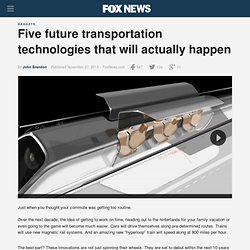

The frictionless vehicle of the future par hielke jensma sur Prezi.
Discovery Channel India. Videos on DiscoveryUK. Corporate. Types of Systems and Components On the ground and above the ground.

Monorail has two types of systems that are all elevated: hung and straddle (above the traffic). On the ground has linked our cities and best used for long distance. Above the ground is best for an urban setting where traffic congestion rules. Here are a variety of ideas showing a robust private sector involvement.. Rail - Over 50 yrs old, the railroad track is the only standard in America, there are over 50,000 miles of existing ROW. Monorail - The best feature of monorail is the elevated guideway above traffic. Other links: The Monorail Society: Elevated Transportation Co Automated GuidewaysHere are hyperlinks to 15 exiting systems in America than run on automated guideways including monorails, aerial trams and people movers.
Sustentation magnétique. Roulis. Avions, trains, voitures : quelles innovations rendent les transports éconénergétiques ? Des véhicules allégés Crédits photo : EPO Norbert Enning et Ulrich Klages Economiser le carburant en allégeant le châssis des voitures : c’est l’idée développée par une équipe d’ingénieurs de chez Audi, dirigée par Norbert Enning et Ulrich Klages.

Brevetée, l’innovation a permis la production de la première voiture à carrosserie en aluminium, ouvrant ainsi la voie à d’autres modèles à poids réduit. Politiques de transport, quel chemin vers 2050 ? - CERIMES. Transports en commun : des innovations écologiques « Le blog de Vadrouille Covoiturage. Pour la semaine du Développement Durable, nous vous proposons de découvrir ou de redécouvrir les meilleures innovations en matière de transport en commun.

On le dit et on le répète, la seule solution d’avenir, autant pour les économies financières que pour la planète, est de faire voyager le plus de personnes possible dans un minimum d’espace (1 véhicule), en un minimum de temps (rapide et sans arrêt), à un prix intéressant, tout en étant facile d’accès. Beaucoup de contraintes, non ? Eh bien c’en est d’autant plus un appel à l’inventivité… Alors voici nos trois innovations préférées, dont deux sont chinoises et une française. Est-ce parce que la Chine est confronté à un défi plus important, pour réduire son taux de pollution et sa consommation de produits pétroliers, que c’est un des pays les plus créatifs en matière de transport et de développement durable ?
Le train qui ne s’arrête jamais. Club innovations transports des collectivités. Five future transportation technologies that will actually happen. Transport Systems Catapult Just when you thought your commute was getting too routine.

Over the next decade, the idea of getting to work on time, heading out to the hinterlands for your family vacation or even going to the game will become much easier. Cars will drive themselves along pre-determined routes. Trains will use new magnetic rail systems. And an amazing new “hyperloop” train will speed along at 800 miles per hour. 2050 and the Future of Transportation. 2050 and the Future of Transportation Frictionless Vehicles and Binary Power will Define Transportation in the World Ahead Transportation technology is progressing at a much slower pace than some of the other sciences such as information technology, biotech, and nanotechnology.

As an example, the world’s human speed record was set in 1969, a full 37 years ago, when Thomas Stafford, John Young, and Gene Cernan flew in Apollo 10 at 24,790 mph. While there is much talk about flying at a speed that approaches the speed of light, very little effort is actually being expended in this area. However, transportation technology is about to move ahead more rapidly in the coming years with the advent of two radically new technologies – frictionless vehicles and binary power. Throughout history we have learned that the two principle driving forces of humanity are freedom and control. Transport concepts for the future - Slideshow - Techworld.com.
The Real Future of Transport. Hot on the heels of the revelation that solar-powered, inflatable turtles are the future of mass transportation, Boeing is showing its vision of the heavy-hauling skies of the the near-future with its JHL-40 Skyhook heli-blimp, a craft it hopes will revolutionize the transport industry for remote, inhospitable places, like the Canadian Arctic.

It is just what it sounds like -- a combination of a blimp with four separate helicopter motors at the sides. The blimp itself, filled with helium, results in an aircraft that is neutrally buoyant in the air; able to stay aloft without any additional power. The four helicopter motors at the corners (not that it really has corners) would be just for lifting, and would in theory allow the thing to carry a 40-ton load up to 200 miles. That compares quite favorably to today's heavy aerial hauler, the CH-47 Chinook helicopter, which can only carry one quarter the load half as far before refueling.
10 Future Public Transportation Vehicles. 8 Ways Magnetic Levitation Could Shape the Future - How Maglev Technology Works. For years, NASA has been researching the possibility of using the high speeds of maglev transportation to fling spacecraft into low Earth orbit.

"It would really open up space to human exploration and commercialization," Powell says. "It's something we can't do now because it's too expensive. " Powell and his colleagues have proposed two generations of space launching technology. The first is a cargo-only launch track that could be built into a mountainside to reach a height of 20,000 feet. Magnets could allow a spacecraft traveling along the track to reach speeds around 18,000 miles per hour—enough to fly into space. And that's just the first generation. Microsoft Word - 09-390,09-395 - cd-2-09-390,09-395.pdf.